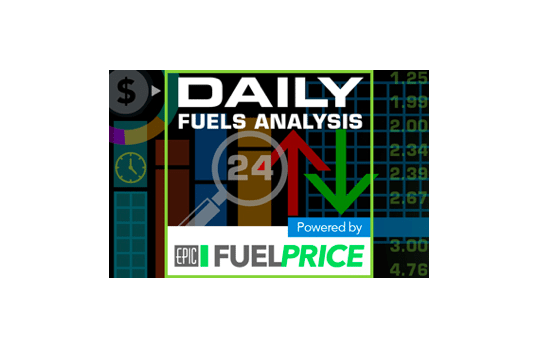Analysis by Dr. Nancy Yamaguchi
The Energy Information Administration (EIA) released its weekly data on diesel and gasoline retail prices for the week ended August 14, 2017. At the national level, prices for both fuels rose, though gasoline prices rose only fractionally. Retail diesel prices increased by 1.7 cents/gallon, while gasoline prices edged up by 0.6 cents/gallon.
The retail price increases were expected since, as noted last week, gasoline and diesel price increases had lagged the increases seen in futures prices for crude oil. Between July 24 and August 14, West Texas Intermediate (WTI) crude futures prices rose by approximately 9.5 cents/gallon. Yet retail diesel prices rose by 7.4 cents/gallon, and retail gasoline prices rose by only 6.6 cents/gallon in comparison. Similarly, the current drop in crude prices is likely to manifest in next week’s average retail prices.
U.S. retail gasoline prices rose modestly by 0.6 cents for the week ended August 14, to an average price of $2.384/gallon. Prices rose in three of five PADDs and declined in the other two. During the most recent week ended August 14, prices were 23.5 cents higher than for the same week in 2016. Gasoline prices have risen for four consecutive weeks, rising by 10.6 cents/gallon since the week ended July 17.
For the current week ended August 14, diesel prices rose by 1.7 cents to arrive at an average price of $2.598/gallon. Retail diesel prices have risen for seven consecutive weeks. Last week’s price hike of 5 cents/gallon was by far the largest. Since the week ended June 26, diesel prices have risen by 13.3 cents/gallon.
WTI crude prices dropped sharply yesterday, shedding $1.20 from open to close. After opening yesterday at $48.79 per barrel (/b), WTI crude closed at $47.59/b. Reports of falling demand in China overwhelmed the impact of a disruption in Libyan oil exports, which had supported prices at around $48.50/b earlier in the session. Citing China’s National Bureau of Statistics, Bloomberg calculated that Chinese refinery runs dropped 4.4% between June and July. Prices also relaxed as U.S.-North Korea verbal salvoes were toned down; equity markets recovered, and the U.S. Dollar rose.
The largest factor keeping a lid on oil prices continues to be oversupply. The market took a more decidedly bearish tilt when the International Energy Agency (IEA) updated its view on global oil inventories. Given the latest forecasts of supply and demand, it may take the entirety of 2018 to begin draining the surplus in global stockpiles.
WTI crude opened at $47.49/b, down by $1.30 from yesterday’s opening. Currently this morning, WTI prices are $47.29/b, down by another 20 cents since today’s opening.









